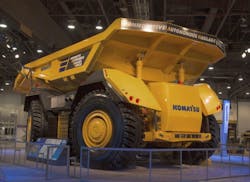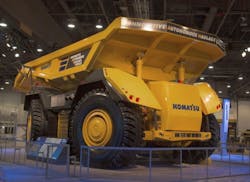Autonomous mining equipment years ahead of car development
Courtesy of Komatsu
A rich assortment of technologies is available to autonomous vehicle designers—radar, GPS, GNSS, LiDAR, ultrasonic, infrared, and video. The suitability of each depends on the vehicle’s surroundings.
Although some driverless-car development programs, such as Alphabet’s Waymo (formerly Google’s self-driving car project), have accumulated years of actual on-the-road test data, a number of obstacles to deployment remain. In addition to legal restrictions and cost, the variability of the operating environment continues to challenge current sensors and algorithms.
In a controlled environment without unpredictable pedestrian and vehicular interactions, the range of constraints becomes more manageable. Rio Tinto’s Yandicoogina mine in Australia is a good example in which 22 driverless trucks were operating in October 2015. Including these 22, the company operated a total of 69 driverless trucks at mine sites in Pilbara, Western Australia, at that time.1
Robotics Business Review reports, “FrontRunner is the product name Komatsu has given its autonomous haulage system (AHS) of high-precision GPS, cross-referencing radars, lasers, computers, video cameras, and communications. Rio Tinto’s … driverless, FrontRunner-equipped 930E-ATs are each equipped with vehicle controllers, GPS, an obstacle detection system, and a wireless network system operated and controlled by a supervisory computer.”2 Each truck weighs 200 tons and is capable of carrying an additional 320-ton payload.
As explained by Josh Bennett, who manages operations at the Yandicoogina mine, “What we have done is map out our entire mine and put that into a system, and the system then works out how to maneuver the trucks through the mine.”1
A 2014 article in Komatsu Australia’s Down to Earth magazine discusses a number of features made available by adding a Topcon global navigation satellite system (GNSS) to the company’s Dash 5 “Vantage” grader.3 From mid 2012, Topcon has based many products on its Vanguard technology. As the Topcon website states, “The [Vanguard] ASIC chipset … has a multi-core design … with access to over 226 receiver channels. Each channel uses Topcon’s patented universal tracking channels technology to track and receive any satellite signal instead of being preprogrammed for a specific signal type or frequency.”
Caterpillar and other mining equipment companies also are providing trucks with autonomous capability. Reference 1 states, “… BHP Billiton and Fortescue Metals Group are following in [Rio Tinto’s] footsteps. FMG, for example, is working with … Caterpillar to ramp up their fleet of autonomous trucks to 45.” More recent 2016 information on the Caterpillar website states that 72 CAT 793F CMD trucks are in use on customer sites and have hauled a total of 360 million tons.
In contrast to the advanced state of AHS vehicles, Google car project (and now Waymo) CEO John Krafcik recently commented that “… readiness of self-driving cars [was] a ‘process, not a point in time.’ So, at first … the cars might provide mobility for people who can be satisfied with a shorter range. As the process improves, the range and top speed should increase and the potential market should grow correspondingly.”4
A Frost & Sullivan white paper5 highlights the advantages of LiDAR, the technology that Waymo is using. “Every measured LiDAR point reflects full X, Y, Z reflectivity data over time, which means that the observer’s point of view can be selected at any location within the scene. With instantaneous visual information from multiple vantage points, the computer analyzes millions of points … to assess conditions of the environment including the lay of the road, road conditions, foot traffic, approaching pedestrians, and vehicle traffic. XYZ points that move together are recognized as objects and, due to the high density of data, can be classified discretely as bicycles, pedestrians, cars, etc.”
A recent article6 discusses Waymo’s attempt to reduce the cost of LiDAR by 90% to make the autonomous car more affordable. According to the article, “Since Waymo is making its own hardware and software, it can find the right balance between cheap-but-not-too-cheap and pair it with software that can make sense of the data.”
References
- Murgia, M., “Driverless trucks transport iron ore at Rio Tinto mines in Australia,” The Telegraph, Oct. 19, 2015.
- Green, T., “Rio Tinto’s $3.6B Bid to Marry Mining to Robotics,” Robotics Business Review, June 29, 2012.
- “Komatsu Graders Aimed Squarely at Contractor Market,” Down to Earth, Issue 63, August 2014, p. 16.
- “Google’s Krafcik talks self-driving vehicle development,” SAE International, Mar. 27, 2016.
- LiDAR: Driving the Future of Autonomous Navigation, Frost & Sullivan, 2016.
- Amadeo, R., “Google’s Waymo invests in LiDAR technology, cuts costs by 90 percent,”
ars Technica, Jan. 9, 2017.
About the Author


